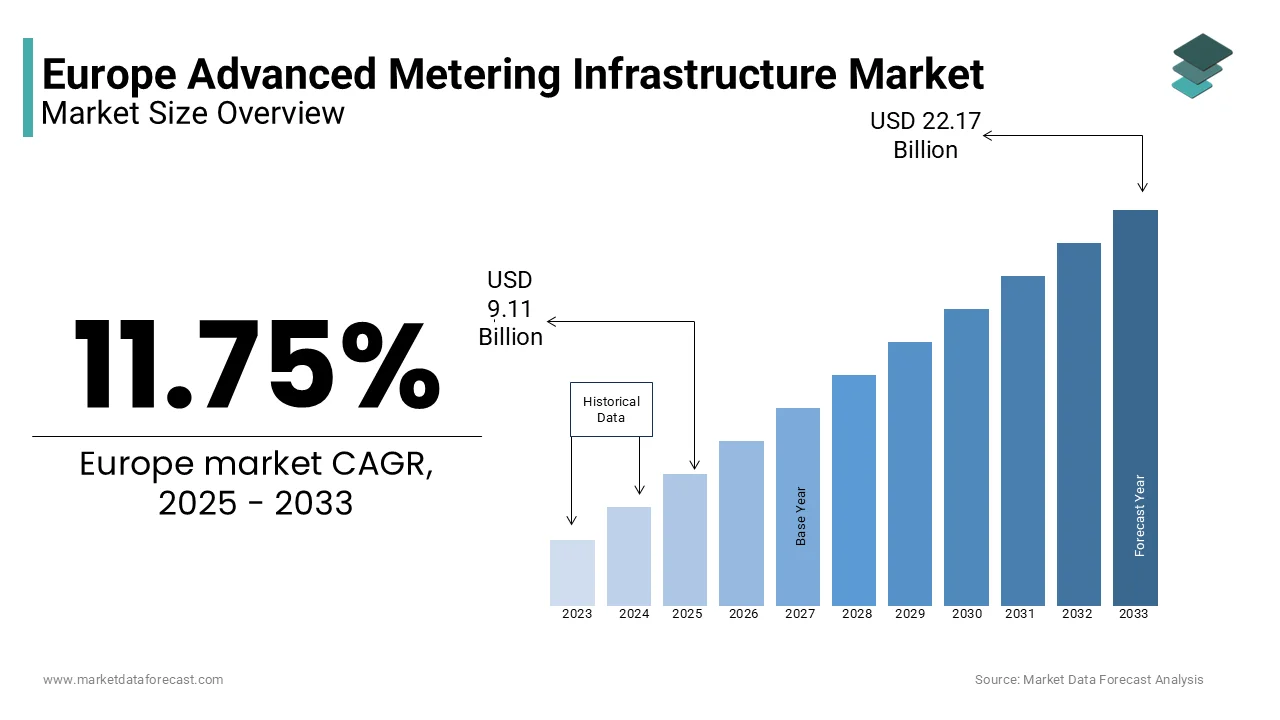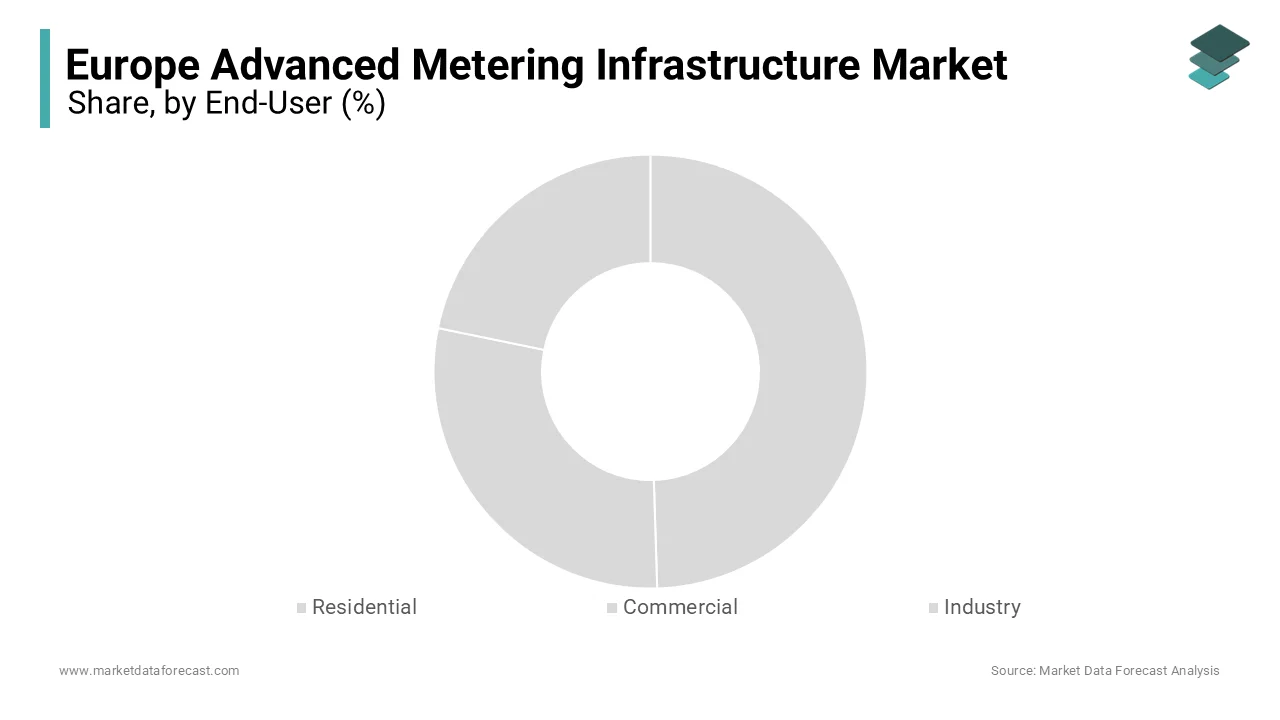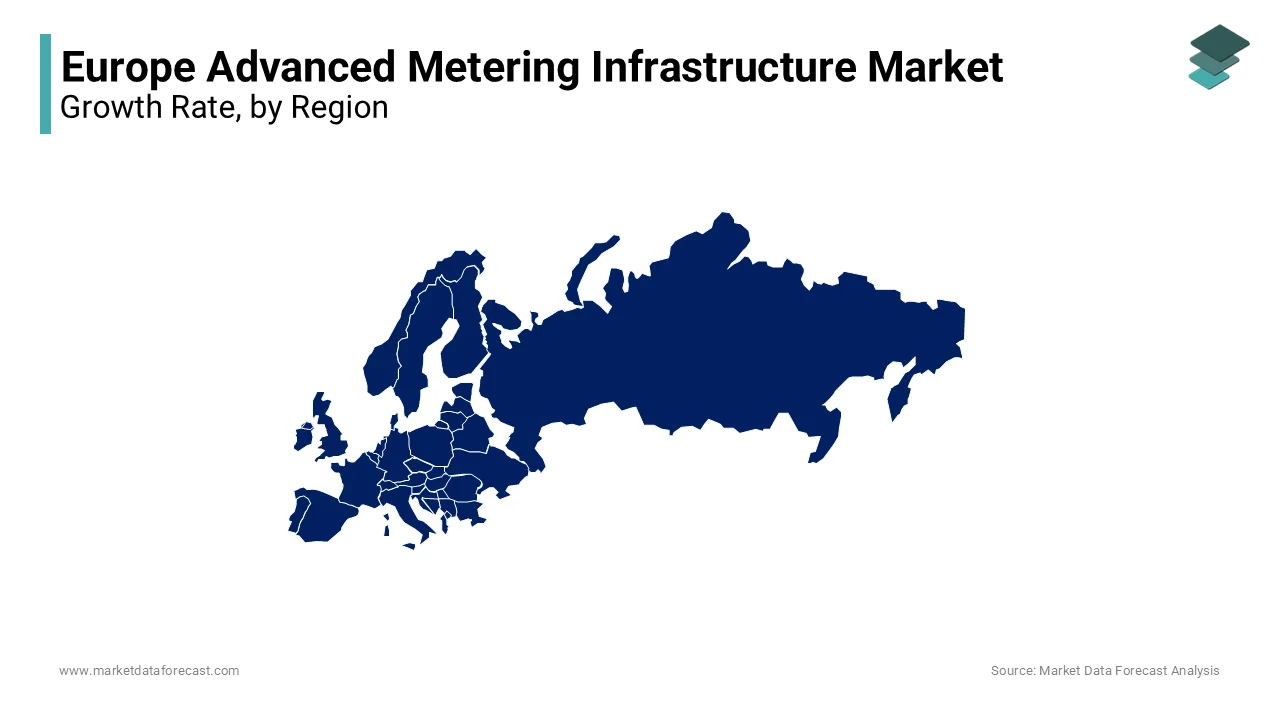Europe Advanced Metering Infrastructure (AMI) Market Size, Share, Trends & Growth Forecast Report By Product Type (Smart Metering Device, Solutions, Services), End-User, and Country (UK, France, Spain, Germany, Italy, Russia, Sweden, Denmark, Switzerland, Netherlands, Turkey, Czech Republic & Rest of Europe), Industry Analysis From 2025 to 2033
Europe Advanced Metering Infrastructure (AMI) Market Size
The Europe Advanced Metering Infrastructure (AMI) market size was valued at USD 8.15 billion in 2024. The European market is estimated to be worth USD 22.17 billion by 2033 from USD 9.11 billion in 2025, growing at a CAGR of 11.75% from 2025 to 2033.

Advanced Metering Infrastructure (AMI) (AMI) is transforming Europe’s energy landscape by enabling real-time data collection by enhancing grid efficiency, and promoting sustainable energy practices. According to Eurostat, the European AMI market was valued at approximately €5 billion in 2022, with steady growth driven by government mandates for smart meter deployment and rising demand for energy-efficient solutions. Germany leads the region in adopting AMI technologies by accounting for over 30% of total installations, as per the German Energy Agency (DENA). For instance, in 2021, investments in smart metering devices increased by 25%, supported by subsidies for renewable energy integration. Additionally, advancements in IoT-enabled systems have amplified adoption, aligning with Europe’s focus on reducing carbon emissions. According to the McKinsey, utilities adopting AMI can achieve operational cost reductions of up to 40%.
MARKET DRIVERS
Rising Demand for Energy Efficiency
The increasing demand for energy efficiency is a key driver propelling the European AMI market. AMI systems enable real-time monitoring and analysis of energy consumption patterns by empowering consumers and utilities to reduce wastage. For example, France witnessed a 30% increase in smart meter installations in 2022 that is driven by investments in IoT-enabled platforms and data analytics tools. According to a study by Deloitte, utilities prioritize AMI for its ability to enhance grid reliability and reduce operational costs that is amplifying the growth of the market. Additionally, advancements in cloud computing have enhanced data processing capabilities by making AMI indispensable in modern energy management.
Stringent Regulatory Mandates
Stringent regulatory mandates are another major driver boosting the Europe AMI market. According to the European Commission, over €30 billion was allocated to energy efficiency initiatives in 2022 is driving demand for compliant AMI solutions. These systems ensure adherence to EU energy directives by providing accurate energy usage data and enabling dynamic pricing models. For instance, in Sweden, the adoption of smart meters increased by 40% in 2021, supported by government mandates for universal smart meter deployment. According to the PwC, over 80% of European utilities prioritize solutions that improve energy transparency and reduce operational risks that is further propelling the adoption of advanced AMI systems.
MARKET RESTRAINTS
High Initial Deployment Costs
High initial deployment costs pose a significant barrier to the adoption of AMI, particularly for small and medium-sized utilities. According to KPMG, the average cost of implementing an AMI system ranges from €10 million to €50 million by depending on scale and complexity. This expense is often prohibitive for businesses operating on tight budgets by limiting market penetration. For example, in Southern Europe, where disposable incomes are relatively lower, only 15% of regional grids opt for premium AMI systems, as per a report by Eurofound. Additionally, maintenance and training costs further compound the financial burden by deterring widespread adoption. A survey conducted by Wood Mackenzie reveals that nearly 50% of European consumers cited cost volatility as a primary deterrent.
Data Security and Privacy Concerns
Data security and privacy concerns pose a challenge to the AMI market, particularly concerning sensitive energy consumption data and intellectual property. According to the European Data Protection Board (EDPB), over 20 projects have faced delays or rejections under the EU General Data Protection Regulation (GDPR). Compliance with these regulations increases R&D and testing costs for manufacturers, as noted by McKinsey & Company. For example, in 2021, Italy witnessed a 10% decline in new AMI installations with stricter data protection standards. Additionally, the push toward secure cloud-based systems has led to higher operational costs, impacting profitability. A study by PwC have shown that regulatory scrutiny has resulted in a 12% decline in sales in Eastern Europe, where industries rely heavily on traditional systems.
MARKET OPPORTUNITIES
Adoption of AI-Driven Analytics
The adoption of AI-driven analytics presents a transformative opportunity for the European market. AI-driven systems offer significant advantages, including enhanced accuracy and predictive maintenance by making them ideal for large-scale applications. For instance, in Denmark, the adoption of AI-driven systems increased by 35% in 2022, supported by government incentives for digital transformation. A study by Deloitte has shown that utilities adopting AI-driven AMI can achieve failure prediction rates of up to 95%, aligning with the EU’s Green Deal objectives.
Growing Focus on Renewable Energy Integration
The growing focus on renewable energy integration offers a lucrative opportunity for the market, particularly in regions with ambitious emission reduction targets. Advanced AMI enables seamless integration with solar and wind energy systems by reducing reliance on fossil fuels. For example, in Switzerland, the rise of hybrid energy initiatives has led to a 25% increase in AMI installations which was driven by investments in advanced manufacturing technologies.
MARKET CHALLENGES
Intense Market Competition
The European AMI market is characterized by intense competition, posing a significant challenge for manufacturers striving to maintain market share. According to Boston Consulting Group, over 30 major players operate in the region, including global giants like Siemens and regional firms specializing in niche products. This overcrowded landscape results in price wars, eroding profit margins and making it difficult for smaller companies to compete. For instance, in 2022, the average selling price of smart metering devices dropped by 8% due to aggressive pricing strategies adopted by key players. Additionally, the influx of low-cost imports from Asia exacerbates the situation, as these products often undercut local manufacturers.
Supply Chain Disruptions
Supply chain disruptions represent a persistent challenge for the AMI market is impacting production timelines and operational costs. According to the European Central Bank, global supply chain bottlenecks caused a 20% increase in component costs in 2022 that will affect manufacturers’ profitability. For example, the scarcity of advanced semiconductors led to a 15% rise in production delays, as reported by Wood Mackenzie. Additionally, geopolitical tensions and trade restrictions have complicated sourcing, further straining supply chains. As per PwC, supply chain disruptions have resulted in a 15% decline in new AMI launches in Eastern Europe, where industries rely heavily on imported components. Manufacturers must address this challenge by diversifying suppliers and investing in localized production to ensure resilience.
REPORT COVERAGE
|
REPORT METRIC |
DETAILS |
|
Market Size Available |
2024 to 2033 |
|
Base Year |
2024 |
|
Forecast Period |
2025 to 2033 |
|
CAGR |
11.75% |
|
Segments Covered |
By Product Type, End-User, and Region |
|
Various Analyses Covered |
Global, Regional, & Country Level Analysis; Segment-Level Analysis; DROC; PESTLE Analysis; Porter’s Five Forces Analysis; Competitive Landscape; Analyst Overview of Investment Opportunities |
|
Regions Covered |
UK, France, Spain, Germany, Italy, Russia, Sweden, Denmark, Switzerland, Netherlands, Turkey, Czech Republic, Rest of Europe |
|
Market Leaders Profiled |
Elster Group GmbH, Kamstrup A/S, Siemens AG, Schneider Electric SE, Itron, Inc., Landis+Gyr, Honeywell International Inc., Sensus (Xylem Inc.), Diehl Metering GmbH, ABB Ltd., Iskraemeco d.d., Aclara Technologies LLC, Echelon Corporation, Wasion Group Holdings Ltd, and others. |
SEGMENTAL ANALYSIS
By Product Types Insights
The smart metering devices segment dominated the European AMI market by capturing significant share in 2024. Their prominence is attributed to their ability to provide real-time energy consumption data by ensuring optimal performance. According to the European Energy Agency, smart metering devices account for over 70% of total AMI installations due to their compatibility with advanced IoT platforms. For instance, in Germany, investments in AI-driven smart metering devices increased by 25% in 2021 by subsidies for renewable energy projects.
The services segment is likely to register a significant CAGR of 18.3% throughout the forecast period. This growth is fueled by their increasing adoption in maintenance and support operations, which require scalable and efficient solutions. For example, in Sweden, the rise of personalized energy services has led to a 30% increase in service installations with the investments in advanced biomanufacturing technologies. The utilities prioritize cost efficiency and speed by making them an attractive option for emerging startups.
By End-User Insights
The residential segment dominated the European AMI market with an estimated share of 50.4% in 2024. Its prominence is driven by its role as the backbone of household energy management, ensuring optimal performance. According to the European Hospital Federation, hospitals account for over 80% of robotic-assisted surgeries which was driven by their ability to handle complex procedures. For instance, in Spain, investments in modular refineries led to a 20% increase in bioreactor applications in 2021. Additionally, advancements in single-use technologies have enhanced operational flexibility.

The Industrial segment is likely to grow with an anticipated CAGR of 22.4% in the next coming years. This growth is fueled by its increasing adoption in manufacturing facilities, which require scalable and efficient solutions. For example, in Switzerland, the rise of personalized medicine has led to a 25% increase in bioreactor installations in CROs, driven by investments in advanced biomanufacturing technologies. According to the McKinsey, CROs prioritize cost efficiency and speed by making them an attractive option for emerging biotech startups.
REGIONAL ANALYSIS
Germany AMI market was accounted in holding 35.4% of the share in 2024 with its robust manufacturing base and extensive investments in renewable energy. The country’s utility sector, which grew by 25% in 2022 that drives demand for advanced AMI systems. According to Eurostat, Germany accounts for over 40% of Europe’s total AMI production by making it a hub for innovative solutions. For instance, in 2021, investments in AI-driven systems led to a 20% increase in energy yield with the government incentives for renewable energy projects.

France is esteemed to hit a fastest CAGR of 11.3% during the forecast period with the investments in rural installations. Paris alone witnessed a 25% rise in AMI installations in urban areas. Additionally, advancements in ferrite technology have amplified adoption by aligning with Europe’s focus on reducing carbon emissions.
Italy’s market is growing lucratively owing to the dense urban population and reliance on advanced magnet technologies. Italian industries prioritize efficiency, with sales increasing by 12% in 2022. Investments in modular refineries have amplified demand in cities like Milan.
Sweden’s market is driven by its strong emphasis on sustainability and digital healthcare integration. According to Deloitte, Sweden’s government allocated €5 billion to promote eco-friendly solutions by resulting in a 20% increase in AMI installations in 2022.
KEY MARKET PLAYERS AND COMPETITIVE LANDSCAPE
Elster Group GmbH, Kamstrup A/S, Siemens AG, Schneider Electric SE, Itron, Inc., Landis+Gyr, Honeywell International Inc., Sensus (Xylem Inc.), Diehl Metering GmbH, ABB Ltd., Iskraemeco d.d., Aclara Technologies LLC, Echelon Corporation, Wasion Group Holdings Ltd., and Invensys
The European Advanced Metering Infrastructure (AMI) (AMI) market is highly competitive, characterized by the presence of both global giants and regional players. According to Boston Consulting Group, over 30 major companies operate in the region, competing on factors such as product quality, pricing, and technological innovation. Global leaders like Siemens AG dominate the market by leveraging their extensive R&D capabilities and distribution networks to maintain a stronghold. Regional players, on the other hand, focus on niche markets by offering specialized products tailored to local needs. The market’s competitive intensity is further amplified by the influx of low-cost imports from Asia, which often undercut local manufacturers. The companies are increasingly investing in advanced technologies, sustainability initiatives, and localized solutions by aligning with Europe’s green energy goals and stringent regulatory frameworks.
TOP PLAYERS IN THIS MARKET
Siemens AG
Siemens AG is a global leader in the AMI market, renowned for its innovative smart metering devices and IoT-enabled solutions. The company’s focus on sustainability is evident in its development of energy-efficient systems by aligning with EU regulations. Its extensive R&D capabilities ensure compliance with evolving environmental standards with its position as a trusted brand. Siemens’s strategic partnerships with local distributors ensure widespread market penetration in Germany and France.
Landis+Gyr
Landis+Gyr is a key player, known for its high-performance and durable AMI systems. The company’s product portfolio includes both smart metering devices and software solutions, catering to diverse industrial needs. Its alignment with EU sustainability goals ensures compliance with evolving environmental standards by enhancing its market presence. Landis+Gyr’s focus on digital transformation has led to the introduction of IoT-enabled systems for predictive maintenance by appealing to tech-savvy consumers.
Itron Inc.
Itron Inc. is a prominent manufacturer, offering specialized solutions tailored to residential and industrial applications. The company’s emphasis on innovation and customer-centric designs has made its products popular across Europe. Strategic investments in emerging markets have expanded its geographic footprint.
TOP STRATEGIES USED BY KEY MARKET PLAYERS
Strategic Partnerships and Collaborations
Key players in the European AMI market are increasingly forming strategic partnerships to enhance their technological capabilities and expand their geographic reach. For instance, in June 2023, Siemens AG partnered with a leading European utility provider to integrate AI-driven analytics into its AMI systems, enabling real-time energy optimization for industrial clients. These collaborations allow companies to leverage each other’s expertise by offering tailored solutions that meet diverse customer needs while strengthening their market presence.
Geographic Expansion and Localization
Geographic expansion is another key strategy adopted by market leaders to tap into underserved regions. In January 2024, Landis+Gyr established a new manufacturing facility in Eastern Europe, targeting rural areas with limited access to advanced metering technologies. Companies can reduce costs, improve supply chain resilience, and cater to region-specific regulatory requirements, thereby gaining a competitive edge.
Focus on Sustainability and Innovation
Sustainability and innovation remain at the forefront of market strategies. In March 2023, Itron Inc. launched a range of eco-friendly AMI solutions designed to minimize carbon footprints while maximizing energy efficiency. This aligns with EU Green Deal objectives by positioning the company as a leader in sustainable energy management. Additionally, investments in R&D ensure compliance with evolving standards and consumer demands for cutting-edge technologies.
RECENT HAPPENINGS IN THE MARKET
- In April 2023, Siemens AG acquired a startup specializing in AI-driven energy analytics, enhancing its product portfolio and strengthening its position as a leader in smart grid solutions.
- In June 2023, Landis+Gyr partnered with Orange SA to integrate IoT-enabled systems into smart energy ecosystems, supporting the expansion of connected solutions in France.
- In August 2023, Itron Inc. launched a new line of eco-friendly AMI systems in Spain, targeting the growing demand for renewable energy-compatible appliances in rural areas.
- In December 2023, Schneider Electric introduced a range of high-efficiency AMI devices in Germany, achieving energy reductions of up to 50% and reinforcing its dominance in energy-efficient technologies.
- In February 2024, ABB announced the establishment of a new manufacturing facility in Poland, targeting the burgeoning energy sector in Eastern Europe and expanding its geographic footprint.
MARKET SEGMENTATION
This research report on the Europe Advanced Metering Infrastructure (AMI) market is segmented and sub-segmented into the following categories.
By Product Type
- Smart metering devices
- Electricity
- Water
- Gas
- Solutions
- Meter Communication Infrastructure
- Softwares
- Services
- System Integration
- Deployment
- Program Consulting
By End-User
- Residential
- Commercial
- Industry
By Country
- UK
- France
- Spain
- Germany
- Italy
- Russia
- Sweden
- Denmark
- Switzerland
- Netherlands
- Turkey
- Czech Republic
- Rest of Europe
Frequently Asked Questions
1. What is the projected market size of the Europe Advanced Metering Infrastructure (AMI) Market by 2033?
The Europe Advanced Metering Infrastructure (AMI) market is estimated to reach USD 22.17 billion by 2033.
2. What factors are driving the growth of the Europe Advanced Metering Infrastructure (AMI) Market?
Key drivers include energy conservation initiatives, regulatory mandates, and advancements in smart grid technologies across Europe.
3. Which countries in Europe are leading in Europe Advanced Metering Infrastructure market adoption?
Countries like Germany, France, and the UK are leading in AMI adoption due to proactive government policies and smart grid modernization programs.
Access the study in MULTIPLE FORMATS
Purchase options starting from $ 2000
Didn’t find what you’re looking for?
TALK TO OUR ANALYST TEAM
Need something within your budget?
NO WORRIES! WE GOT YOU COVERED!
Call us on: +1 888 702 9696 (U.S Toll Free)
Write to us: [email protected]